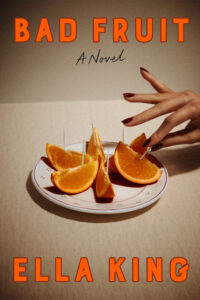
During an oppressively hot British summer, 17-year-old Lily from Singapore grapples with a suffocating domestic predicament. Unable to escape the tempestuous outbursts of her abusive mother May, Lily diligently tries to shield her family from the flares of May’s wrath by offering her mother’s beverage of choice—tainted juice. The dynamics at home take an unexpected turn as Lily’s visions reveal murky glimpses into May’s traumatic history, prompting an exploration of the deeper reasons behind the matriarch’s volatile behavior.
Amidst the chaos, Lily’s sister Julia deliberately incites May’s ire, escalating tensions at home. Meanwhile, Lewis, a benevolent ally, strives to unlock the mystery behind Lily’s enigmatic visions. As the summer intensifies, bringing May’s envy and retaliation to new heights, Lily endeavors to maintain a safe distance from her wrathful mother, simultaneously attempting to discern the truth concealed behind May’s mask.
Our Culture engaged in a discussion with Ella King about her first literary work, its origins in her anti-trafficking advocacy, and the complexities of inherited psychological wounds.
Ella, congratulations on the publication of your first book! How has it felt to witness its swift success across the UK and US?
It’s exhilarating and surreal to see my creation enter the world and engage readers. I’m fascinated by the diverse reactions it garners. It seems the relevance of the racial themes varies among readers, landing differently with each individual. It’s captivating to observe people’s interpretations. The journey from conception to realization is indescribable—the book’s outward journey into readers’ minds is particularly intriguing.
Set in the confines of a single scorching summer, the novel presents an intriguing contrast. Typically, summer symbolizes liberation, yet here it compounds Lily’s entrapment.
Indeed, the heatwave constructs an unusual transitional phase for Lily, a precursor to her impending college life. It’s a time to reflect on her familial role and its imminent evolution. The intense season we’ve recently experienced in the UK mirrors Lily’s family’s escalating drama, thrusting each character into heightened states. The climate seemingly mirrors the characters’ intense inner workings amid constrained familial circumstances.
The story has a whimsical, otherworldly aura, reminiscent of fairytales. Was this a conscious choice or an organic development?
Your insight is intriguing. Some early critics mistook my narrative for fantastical young adult fiction, prompting me to clarify my intentions. The peculiar places you’ve noted are indeed grounded in reality—written against the backdrop of my neighborhood wanderings while soothing my newborn. Notions of making a profound literary statement were far from my mind; I was simply encapsulating the world around me, as tangible as the pavements under my feet.
The narrative, while not overly youth-centric, does exude an enchanting sheen that positions it slightly beyond the mundane.
Reader extrapolations are what give writing its wings. The story may not have been conjured with such ethereal qualities intentionally, but they add another dimension to its impact. It’s exhilarating when your creation assumes a life of its own, molding itself to others’ imaginations beyond the creator’s initial scope.
Your experiences as an attorney and advocate strongly inform this intense domestic narrative. Did you draw directly from your personal journey?
Without a doubt. The central motif of generational trauma stems from my work in the field. My stint in Cambodia, observing the harrowing normalcy of child trafficking amid a society reeling from genocide, left a profound imprint. Similar patterns emerged even back in the UK with survivors of domestic violence. There’s an imperative need to analyze the transition from suffering to inflicting suffering—shedding light on this suppressed aspect of abuse was imperative for me.

May, the protagonist’s mother, presents a blend of unpredictable fury and deep-rooted suffering that simultaneously alienates and evokes understanding. What were the inspirations for her character?
May is a convergence of many real-life individuals I’ve encountered. She personifies the perplexing normalization of trauma where the gravity of her misdeeds lacks resonance against her personal history of anguish. She’s an enigma—simultaneously the antagonist yet also, fundamentally, the nucleus of the narrative. Dissecting her past trauma and her approach, or lack thereof, toward motherhood is key to the story’s progression.
Smaller chapter sizes seem to offer readers a respite amidst the narrative’s overwhelming intensity. Were there scenes that even you found challenging to pen?
The writing process itself wasn’t daunting, given my familiarity with such distressing scenarios. However, it was the psychological research, the stark data on trauma’s prevalence and impact on the brain, that proved to be staggering. Introducing Lewis as a pivotal figure reflects the rehabilitative power held by supportive adult figures in breaking the patterns of generational trauma—his inclusion underscores the urgency of addressing what lies beneath the surface.
The novel explores May’s tempest of emotions, initially seen as senseless, later finding some grounding in her own tragic upbringing. Is there a possibility of her changing for the better?
Change feels elusive for someone like May. Generational barriers, coupled with an absence of therapeutic tradition, render self-reflection and transformation difficult. While others may ponder the characters’ futures post-narrative, I surmise May would continue undeterred, suppressing the events as she did her own childhood traumas. Discussing a fictional entity is curiously odd.
The story’s racial tensions, as filtered through the differing appearances of the siblings, create layer upon layer of identity conflict. How does this relate to Lily’s personal journey?
Your perspective is astute—each sibling reflects facets of the parental traits, with Lily representing a canvas upon which May projects her own desires and frustrations. May’s attempts to reshape Lily’s identity are cruel ironies entangled with her conflicted feelings towards her husband. The complex interplay between parent and children is laid bare, each child bearing the brunt of May’s emotional turmoil in starkly different ways.
With such a powerful debut, what lies on the horizon? Do you intend to delve into similar thematic landscapes or embark on a novel approach in your future works?
Tales of trauma will likely remain a recurring theme as they resonate deeply with me. My next work reimagines Lolita from a feminist lens, challenging the fabrications of Humbert Humbert by presenting a grown-up Lolita opposing her past tormentor. It’s a narrative of confrontation and vendetta, seen through the eyes of a survivor.